Before delving into the activation of macros within your Excel worksheets, it's imperative to grasp the intricate nature of their potential hazards.
While VBA codes prove highly efficient in automating intricate and repetitive tasks, they concurrently pose a substantial security risk. Inadvertently executing a malicious macro could result in severe consequences, including damage to or complete deletion of files, data corruption, and even the compromise of your Microsoft Office installation. Consequently, Excel defaults to a cautious stance, opting to disable all macros by default and prompting users with notifications.
To circumvent these perils, adhere to a straightforward rule: exclusively enable macros deemed safe – those personally crafted or recorded, those sourced from trustworthy origins, and VBA codes thoroughly comprehended.
How to enable and disable macros in Excel
Empowering Macros for Individual Workbooks
Enabling macros for a specific file offers two avenues: directly within the workbook or through the Backstage view.
Activation via the Security Warning Bar
Under default macro settings, upon opening a workbook featuring macros, a conspicuous yellow security warning bar materializes just below the ribbon:
Enabling macros via security warning bar
Should the Visual Basic Editor be open during file access, the Microsoft Excel Security Notice takes precedence:

Microsoft Excel Security Notice
Should you trust the file's source and verify the security of its macros, proceed to click the "Enable Content" or "Enable Macros" button. This action designates the file as a trusted document, eliminating future security warnings upon subsequent openings.
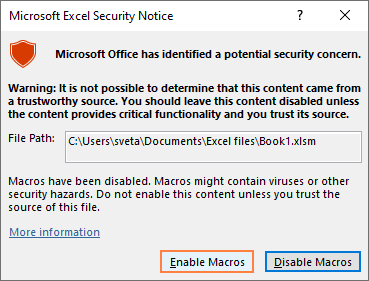
If the file's origin remains uncertain, and macro activation is undesired, opting to close the security warning (via the 'X' button) maintains macro deactivation. Any attempt to run a macro prompts the following message:
A warning that macros have been disabled
Accidentally disabling macros can be rectified by reopening the workbook and clicking the "Enable Content" button on the warning bar.

Enabling Macros through Backstage View
An alternative method involves activating macros via the Office Backstage view:
- Click the File tab and select Info from the left menu.
- In the Security Warning area, choose "Enable Content" followed by "Enable All Content."
Similar to the previous method, this transforms your workbook into a trusted document.
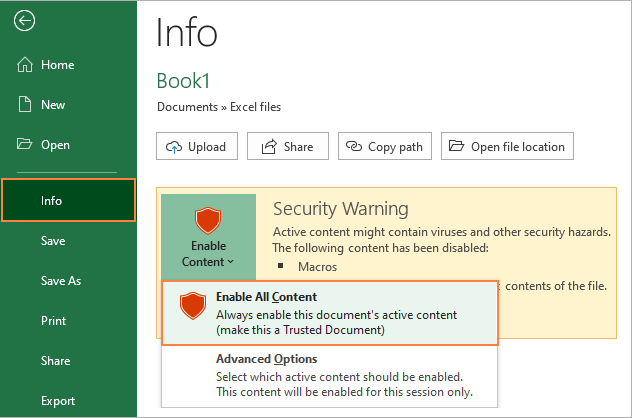
Unveiling the Dynamics of Trusted Documents in Excel
While activating macros either via the message bar or Backstage view designates a file as trusted, certain Excel files resist this classification. Examples include files opened from unsafe locations, such as the Temp Folder, or when organizational security policies disable macros without notification. In such instances, macros are temporarily enabled, necessitating reactivation with each subsequent file opening. To preempt this, adjustments to Trust Center settings or saving the file to a trusted location are recommended.
Once a workbook achieves trusted status, reversal is impossible. Clearing the Trusted Documents list is the sole recourse:
- Navigate to File > Options.
- Select Trust Center on the left and click Trust Center Settings.
- In the Trust Center dialog box, opt for Trusted Documents.
- Click Clear and confirm with OK.
This action renders all previously trusted files untrusted, reinstating the security warning upon file access.
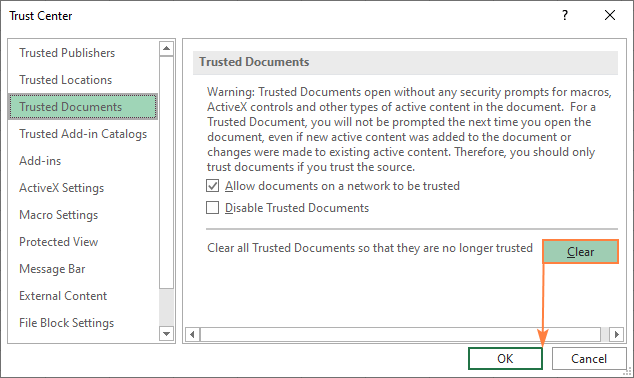
Addressing "Microsoft Has Blocked Macros"
Recent Excel versions alter the approach to macro-enabled files downloaded from the internet. Instead of the conventional yellow Security Warning, a red Security Risk bar emerges, proclaiming, "Microsoft has blocked macros from running because the source of this file is untrusted."
Security warning: Microsoft has blocked macros from running because the source of this file is untrusted.
Clicking "Learn More" merely redirects to a web page, offering insights but withholding macro unblocking capabilities.

Unblocking Macros Blocked by Microsoft
To unblock a macro impeded by Microsoft, follow these steps:
- Close the workbook with the blocked macro.
- In File Explorer, locate the saved workbook.
- Right-click the file, choose Properties, and tick the Unblock box before confirming with OK.
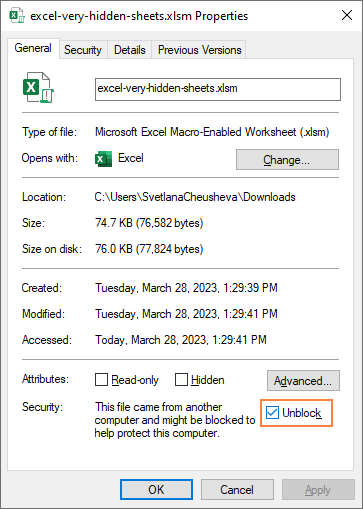
Macro Enablement for a Single Session
Certain scenarios warrant enabling macros for a sole session, preserving the file's untrusted status. Here's a step-by-step guide:
- Navigate to File tab > Info.
- In the Security Warning area, select "Enable Content" > "Advanced Options."
- In the Microsoft Office Security Options dialog, choose "Enable content for this session" and confirm with OK.
This transiently activates macros, with the warning resurfacing upon subsequent file openings.
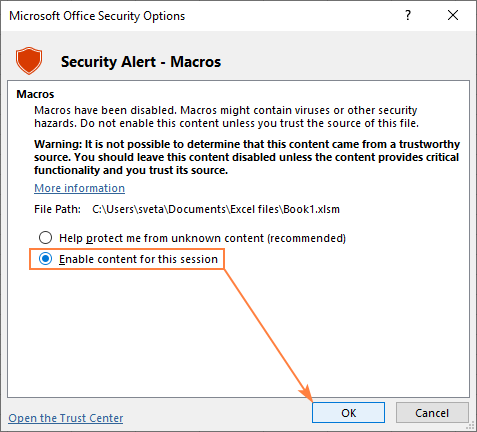
Global Macro Enablement via Trust Center
Excel's macro decision-making relies on Trust Center settings, governing all security aspects. To universally enable macros in all Excel workbooks, adhere to these instructions:
- Click the File tab and choose Options at the bottom of the left bar.
- Select Trust Center on the left and click Trust Center Settings.
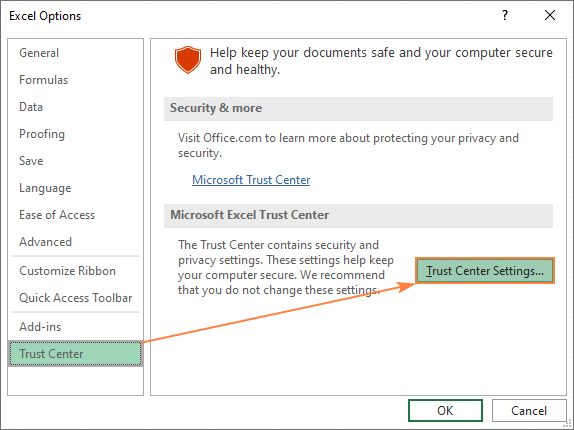
Trust Center Settings
- In the Trust Center dialog box, navigate to Macro Settings, select "Enable all macros," and confirm with OK.
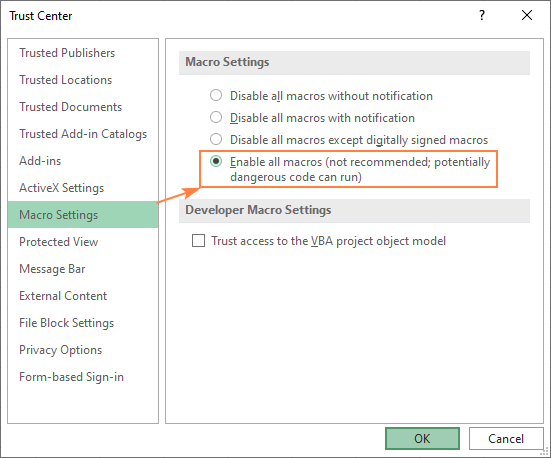
Important considerations:
- Trust Center modifications become the new default macro setting, impacting all Excel files globally. For selective macro enablement, confine files to trusted locations.
- Enabling all macros elevates vulnerability to potentially harmful code.
Insights into Excel Macro Settings
Understanding Trust Center macro settings is pivotal for informed decision-making. Here's a succinct overview:
- Disable all macros without notification: Total macro lockdown; no warnings, except for trusted location macros.
- Disable all macros with notification (default): Macros remain disabled, permitting case-by-case enablement.
- Disable all macros except digitally signed: Unsigned macros trigger notifications; trusted publisher-signed macros alone run.
- Enable all macros (not recommended): Unrestricted macro access, including potentially malicious codes.
- Trust access to the VBA project object model: Governs programmatic access to Visual Basic for Applications, deactivated by default for security.
Remember, Trust Center settings exclusively apply to Excel, not the entire Office suite.
Permanent Macro Enablement in Trusted Locations
Instead of globally adjusting macro settings, designate specific locations as trusted, ensuring macro-enabled file access without security warnings. Notable examples include the Personal Macro Workbook, where VBA codes persistently remain accessible upon Excel startup.
To manage trusted locations:
- Click File > Options.
- Select Trust Center on the left and click Trust Center Settings.
Adding a new trusted location
- In the Trust Center dialog, opt for Trusted Locations, view default locations, and add new locations.
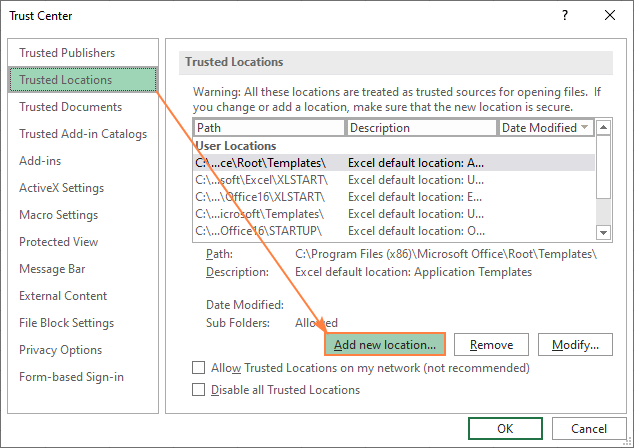
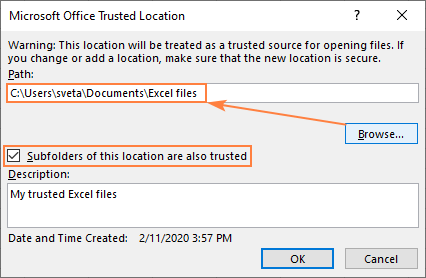
Prudent tips:
- Exercise caution in selecting trusted locations to prevent inadvertent macro vulnerability.
- If an erroneous folder gains trust status, rectify by selecting and clicking Remove.
Programmatic Macro Enablement with VBA
A common inquiry on Excel forums pertains to programmatic macro enablement upon workbook opening and subsequent disablement on closure. Unfortunately, due to the criticality of macro security, Microsoft restricts VBA code triggering to user-initiated actions.
However, a workaround involves a creative implementation, compelling users to enable macros via a "splash screen" or "instruction sheet." The principle entails:
- Crafting code that renders all sheets (except one) very hidden (xlSheetVeryHidden).
- Displaying a visible sheet (splash screen) urging macro enabling or providing detailed instructions.
This approach circumvents the impossibility of programmatically enabling macros, leveraging user engagement for activation.
Disabling Macros in Excel
Excel's default stance is to disable macros with notification, allowing manual enablement. For silent macro deactivation, follow these steps:
- In Excel, click the File tab > Options.
- Choose Trust Center on the left and click Trust Center Settings.
Disabling macros in Excel
- In the left menu, select Macro Settings, opt for "Disable all macros without notification," and confirm with OK.
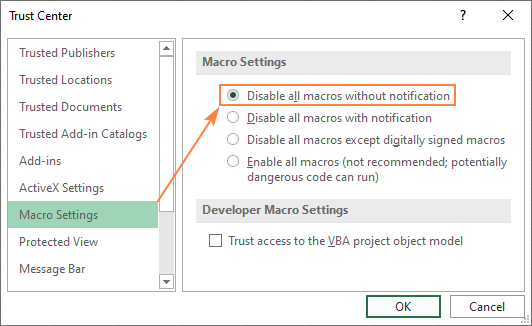
This concludes the guide on enabling and disabling macros in Excel. Your dedicated readership is appreciated, and we eagerly anticipate your return to our blog next week!
FAQ's
Q: Can I enable macros for a specific Excel workbook only?
A: Yes, you can enable macros for a specific Excel workbook. Follow these steps:
Open the workbook containing the macros.
-If the workbook opens with macros disabled, you'll see a security warning at the top of the workbook. Click on "Enable Content."
-there is no security warning, or if you want to change the settings, go to the "Developer" tab in the ribbon (if the "Developer" tab is not visible, you can enable it in the Excel Options).
-In the "Code" group, click on "Macro Security."
-In the Macro Security dialog box, choose "Enable all macros" or "Enable all macros with notification" for this workbook.
-Click "OK" to apply the changes.
-Now, macros are enabled for the specific workbook, and you won't be prompted again unless you change the settings.
Q: Why does Excel display a security warning when I open a workbook with macros?
A: Excel displays a security warning when you open a workbook with macros to ensure the safety of your computer. Macros can contain potentially harmful code, and Excel prompts you to enable or disable them based on your security settings. If you trust the source of the workbook and its macros, you can click "Enable Content" to allow the macros to run. If you're unsure or don't trust the source, it's safer to disable macros or investigate further before enabling them.
Q: How do I check if a workbook contains macros?
A: To check if a workbook contains macros, follow these steps:
-Open the workbook in Excel.
-Go to the "View" tab in the ribbon.
-In the "Macros" group, click on "Macros."
-In the Macros dialog box, you'll see a list of available macros for the workbook. If the list is empty, there are no macros in the workbook.
Alternatively:
-Press Alt + F11 to open the Visual Basic for Applications (VBA) editor.
-In the Project Explorer window, look for any modules or objects listed under the workbook's name. Macros are often stored in modules.
-If you don't find any macros, the workbook is macro-free. If there are macros and you're unsure about their origin or purpose, exercise caution and consider the security implications before enabling them.
Q: Can I password-protect my macros in Excel?
A: Yes, you can password-protect your macros to add an extra layer of security. Follow these steps:
-Open the workbook containing the macros.
-Press Alt + F11 to open the Visual Basic for Applications (VBA) editor.
-In the Project Explorer window, find the module containing your macros.
-Right-click on the module and select "VBAProject Properties."
-In the Properties window, go to the "Protection" tab.
-Check the box for "Lock project for viewing."
-Enter and confirm a password.
-Click "OK" to apply the password protection.
Now, anyone trying to access or modify the macros will be prompted for the
password. Keep the password secure, as it's necessary to unlock the project.

You must be logged in to post a comment.